It’s finally spring on the mountain, which means wild plant foods and medicines are popping up all over the mountain! Join us as we learn about some of these important wild sources of food both historically and now, and go on a short foraging walk with local herbalist Cara-Lee Langston of Wildcraft Kitchen. In a time when food shortages are a real threat, and healthy immune systems are needed more than ever, considered turning to your backyard as a source of vitamin-rich foods like dandelions and violets! As always, please follow sustainable harvesting practices and make sure the plants (or weeds) you pick are free of any chemical treatments in the area.
Learn about sustainable practices here
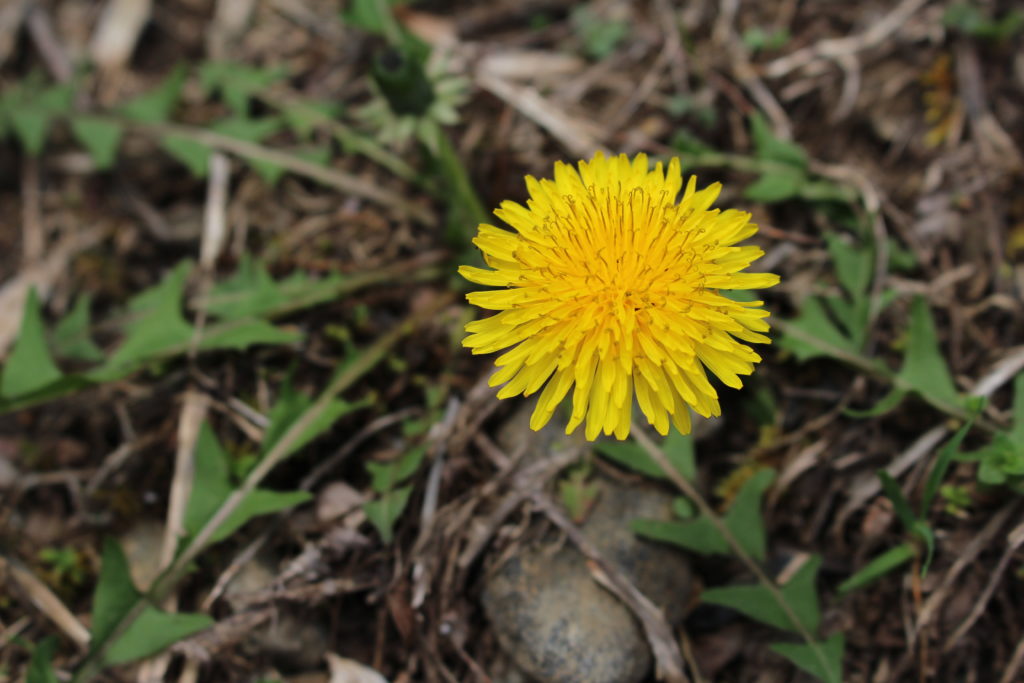
Dandelion (Taraxacum officinale)
Transcripts
Cara-Lee Langston
- One of the plants that is poppin’ up all over my garden right now is wood sorrell. Or oxalis–there’s so many different varieties of oxalis. And South Africa is known to have a lot of oxalis that’s endemic to that region–which means it’s only found in that region. Similarly, there are a lot of plants that are endemic to Rabun County and the southeast Appalachians that you don’t find anywhere else in the world. So, that also made those two places a lot more special to me, thinking about them that way. So oxalis is one of them, we also have lamb’s quarters in South Africa. Chenopodium album, I think, is it’s Latin name. And you can nibble on those when you’re out foraging in the woods, so that’s something that took me back home too. Nibble on a piece of lamb’s quarter up here and then imagine myself hiking up Chapman’s Peak in Cape Town, so. It’s a neat thing when those memories can help you connect like that. And I find that with food as well.
- You know, I’m a big forager, so at the moment I’m eating a lot of greens. And I’m picking greens from out of the woods, and things like that, and just putting together simple salads. And I love making my own dressings from scratch. So in the summertime, when it’s hot like that, I like to put together things like that, that are simple and quick and easy. But in the winter, I gravitate more towards stews and one-pot meals cooked over an open fire. I guess that reminds me then that one of my favorite traditional South African dishes is called potjiekos and we take a big Dutch oven pot and put it over a wood fire and we add, you can add meat to it or you can just do veggies, but you layer it with your heaviest veggies on the bottom. Your meat would go on the bottom as well. And say potatoes and carrots and then your lighter veggies go up top–maybe green beans sitting on the top of the poitke. And you just let it cook slowly over several hours over the open fire. You don’t really mix it through a whole lot. But it’s seasoned with coriander, and often times we’d use lamb or beef, but you could do chicken, you could do pork.
- I love to go wildcrafting, I love to go harvest–sustainably harvest–wild plants to make remedies or use in my cooking.
- (How do they make sure it’s sustainable?) So there are a couple things you need to look out for. A good forager always observes their areas for at least a year. And watches the plants grow through all of its cycles. And gets to know if there’s any wildlife relying on those plants or any other plants relying on those plants. You also have to study the plants in its community and see what’s around it, because they work in a network and they all work together and sometimes rely on each other. So always observe for a good year, through all the seasons. And you always want to make sure that if you’re harvesting, you’re not overharvesting. You want to make sure you’re finding a stand of plants–which means several plants, many plants together, several stands would be even better. And you have to walk and really cover some ground to make sure that you’re not taking everything. And you know, I kind of tend to follow more of a one-in-eight rule. If I see, for instance, eight elderberry bushes, I’m only going to take something maybe from one. And I’m not going to take all of the elderberries or flowers from that one, I’m going to take just what I need. Not deplete its resources.
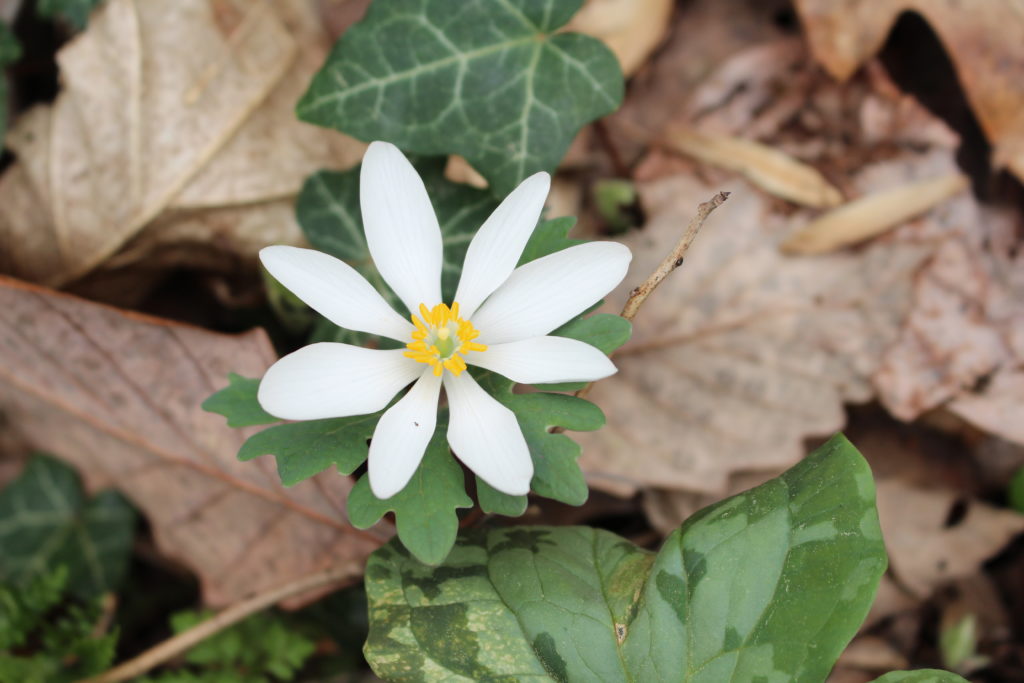
Bloodroot (Sanguinaria canadensis)
Annie Perry
- FF: What about poke salad? Can you make anything…
- AP: I never did can none of it, but I did cook it. Parboil it–I’d boil it ‘til it gets tender, then take it out and wash it. And then put it, after I get it washed good, I put it down in grease and fry it. Put eggs in it.
- FF: Do you still do that now?
- ?P: She fixes some sometimes in the spring of the year when the stalk is young and tender.
- AP: You can cook it without puttin’ the eggs in it, but
- FF: More flavor or something?
- AP: Yeah it’s a little better with the eggs in it.
- FF: It sounds delicious.
- AP: I like it pretty good. It’s poison though–poke salad is poison not to cook it and parboil it.
- AP: Did you ever drink any sassafras tea?
- FF: No I didn’t.
- AP: Well a lot of folks likes it.
- FF: Is it good for anything?
- AP: Not that I knows of. They just like it, tastes good. Now that’s what I was tryin’ to think of–spignet root.
- ?P: …you get it in coves and hollers, with rich black dirt. It smells the best.
- FF: Spigmen?
- ?P: Spignet I guess, spignet.
- FF: Wow.
- ?P: It’ll fool you, if you don’t know ginseng, the leaves, it’ll fool you, it will.
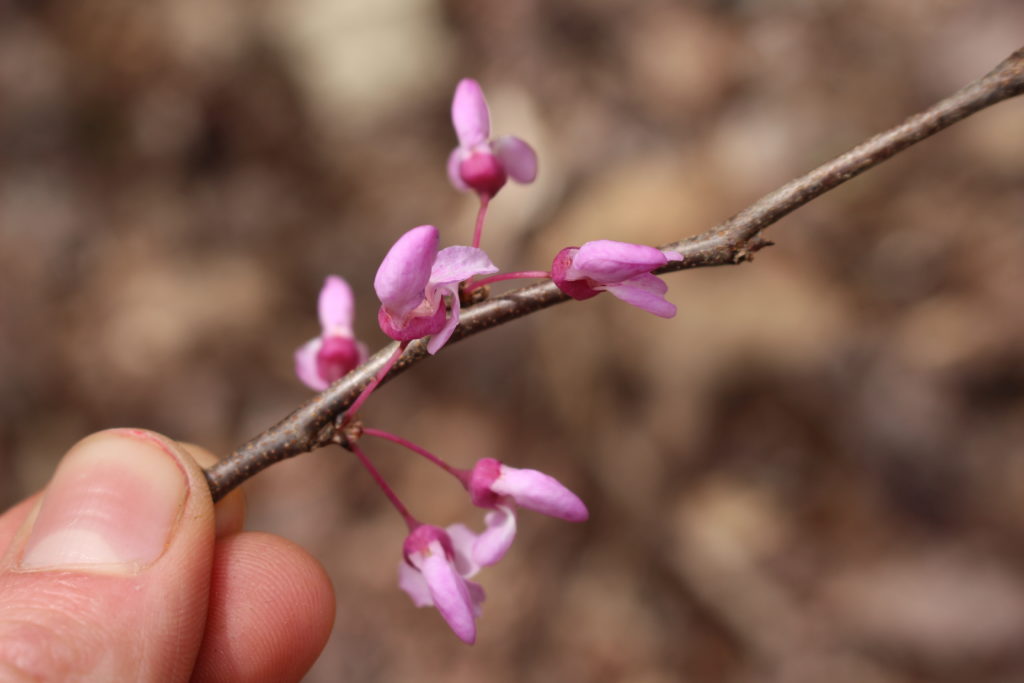
Eastern Red Bud (Cercis canadensis)
Ethel Corn
- Briar leaves and peppergrass (Lepidium virginicum)–you know, briar leaves. And put ‘em on, cook ‘em just like you would turnip salads, and season with salt. That’s the way that they eat ‘em
- FF: Did they fry ‘em or anything?
- EC: No, they just boil it.
- FF: Well what was some of them other kind that you said?
- EC: Well now people would get out and get white dock and mix with it horseradish leaves, and you put it on and parboil it ‘til it’s tender and then you put it out in a pan and fry it. Then there’s cochan (Sochan, Rudbeckia laciniata)–they pick it when it’s tender, and you have to parboil it, take it out, and wash it good, and til your water’s clear, then squeeze it out and put it in a pan with grease and fry it. And you find it along branch banks, is where it grows at.
- FF: What does it look like?
- EC: It look sort of like golden globe flowers. And it’ll run up when it goes up to seed and have a yeller bloom on it. And it grows big, but you have to watch in pickin’ it because wild parsnip looks similar to it, only it’s more of a whitish leaf than that.
- FF: And is parsnip poison or somethin’?
- EC: Yeah, wild parsnip is poison, it’ll kill you.
- FF: What about this poke salad, stuff like that? Is it–how do you do it?
- EC: Well, you pick it when it’s tender and parboil it good and tender and you fry it then wash it, fry then break you some eggs in it and fry it with eggs. But most of the old people fried their’un just plain. And it is the healthiest thing, the doctor says that everybody should eat one or two messes of poke salad every spring. That it was worth more–Doc Neville is the one that said it–that it was worth more than medicine to people. And you can take the stalks when they’re right young and tender, before they get pecky (?) and you can peel ‘em and cut ‘em up round and put salt and black pepper and roll ‘em in meal and fry ‘em and they eat like shrimp.
- FF: Like shrimp?
- EC: Yeah, they taste like a shrimp.
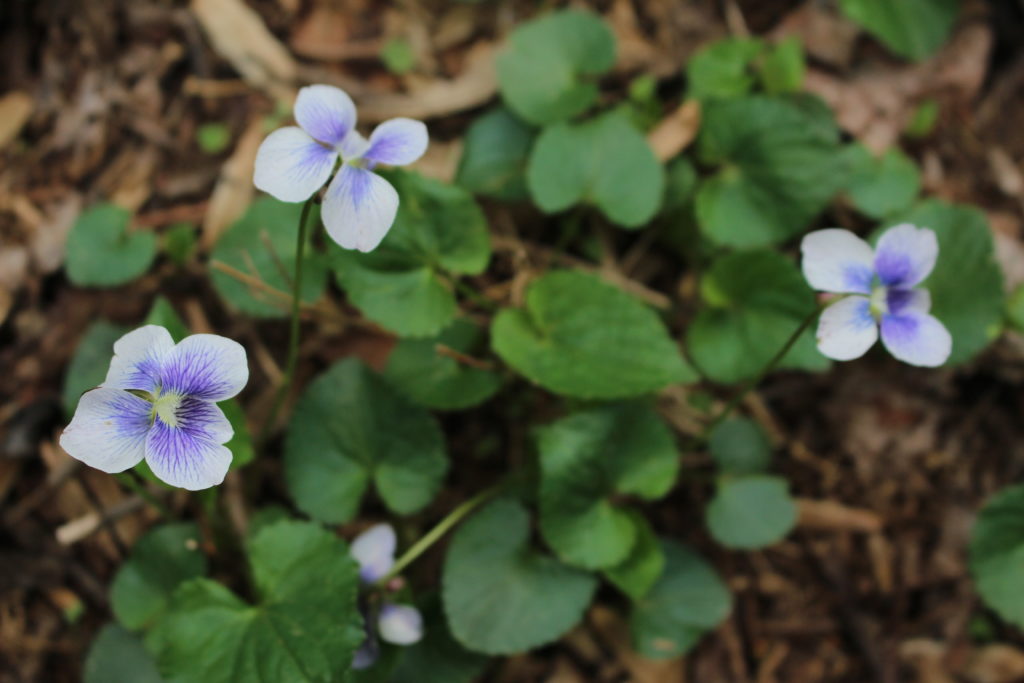
Common Blue Violet (Viola sororia)
Harriet Echols
And a lot of people would get the poke (Phytolacca americana) salad. And I would get the wild poke and put with it–and I don’t like the poke salad too much, right by itself, but I love it. But I like a handful of mustard or something else to go with it. But it’s delicious. And did you know, you can make the most delicious pickle–you know where it comes up and has that little stalk about like that? Pick your greens off and just tenderize–just scald you might say in boiling water that little stem and make a pickle.
- FF: I bet that would be good
- HE: Oh it’s delicious! My mother never failed to make my dad poke stalk pickles. And you know, I like that little stalk. I pick that off and cook it with my greens.
- FF: I do too.
- HE: And you know Grandma Cabe over there? Oh she’d have a fit if she knowed she had to buy a poke salad. And poke berries around this time. I’m goin’ to make pokeberry wine. I don’t know how to fix it yet, but I’m goin’ to find out, or I’m goin’ to try. And they tell me if you fix it, it’s just like any other wine but it doesn’t take as much sugar–a tablespoonful three times a day. And it’s worth a try!
- HE: You don’t find too much of everything right at first in the spring, and you just go hunt about. I do here, and Agnes’s husband just has a fit. He thought at first he wouldn’t–and he loves greens–he wouldn’t eat a spread of poke (?). And I had got some curly kale and a little package of seeds, and a little had come up in the fall and some had come up from the roots in the spring you know. And I had got out and got enough to have us a good mess for supper. Well he just looked at it and said, “Russel, that isn’t poke salad. That’s curly kale.” Well he just ate and ate and he said, “Well it was poke salad at the meal.” He got through–it tickled me to death, he still didn’t trust us and we did have poke salad.
https://www.fs.fed.us/wildflowers/plant-of-the-week/phytolacca_americana.shtml
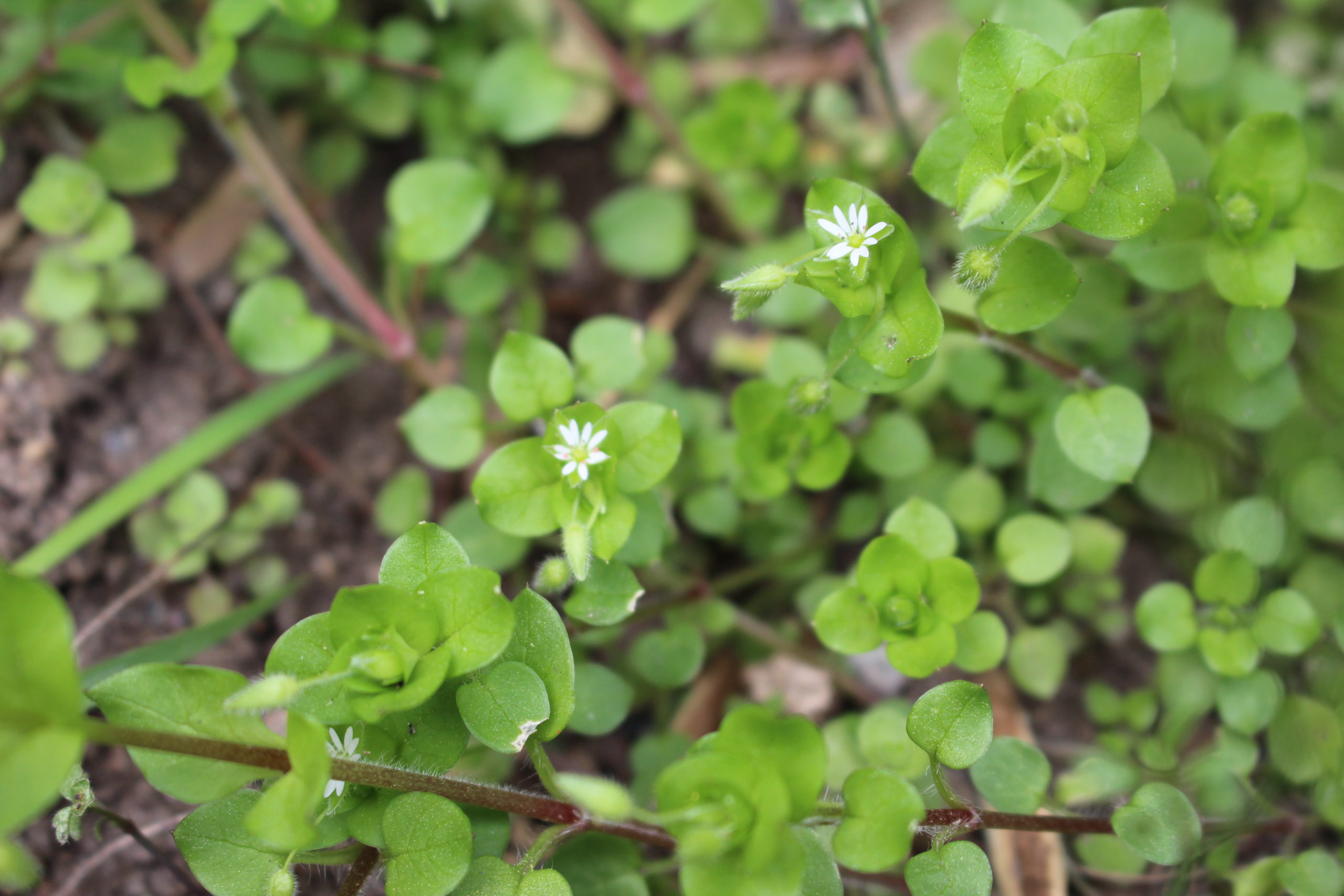
Chickweed (Stellaria media)
Lola Cannon
- Well you know, there’s hardly anything growing in the mountains that’s not eatable. You know, the bamboo stalks are good. You watch when they first make a little hump in the ground as they’re comin’ through, if you dig down, it’s oh four or five inches of big, tender white stem. You slice that, cut it crosswise like okra, and it’s a Chinese food alright. It has, it’s real good. But you have to be real careful to get it while it’s tender.
- FF: You fry it?
- LC: No, you fry it or put it in soups. Anyway–I haven’t tried any of it raw.
- FF: What’s it taste like?
- LC: Well, like any Chinese food. Kind of bland, you need soy sauce or something, it don’t have much flavor. They say it’s real good, real full of vitamins. You know, there aren’t too many things growing in the mountains that’s not good to eat.
- FF: Anything else you can remember?
- LC: Well, the poke salad, you’ve seen that prepared. And there’s a little, I guess you’d call it a weed–lamb’s quarter. Has little funny shaped leaves. And in the spring, they are delicious in a salad or they’re equally good cooked for greens. They too are like the poke salad, you know you must cook the poke salad and drain the water off, because it contains too much of something if you don’t. But this little lamb’s quarter–too, and people use it like rhubarb for making pie. It has kind of a sour taste. It makes a delightful cobbler pie.
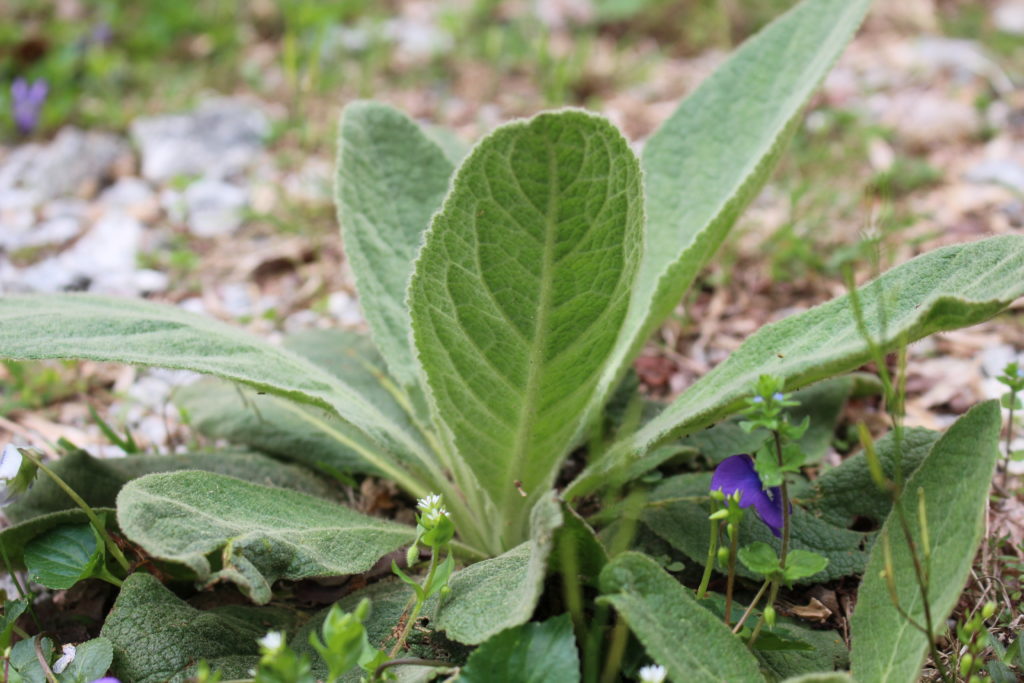
Mullein (Verbascum thapsus)
Jake Waldroop
- Get wild cherry bark and they’d make tea out of that. They’d mostly have that for the spring of the year. They said that was the best tonic, you know, that all of ‘em believed a whole lot in the spring of the year that they had to build their health up some. And they’d really go for that wild cherry bark. They’d take that and scrape it off and peel it out, you know, and put it in water or put it in a container sometimes. And some of them, if they could get it, they’d put a little moonshine whiskey in with it. Some of them used to have a joke and say, why, get their bark and put it in the box and get their moonshine and set it in on top of it in the jug. That was more of a joke. What they actually done is make bitters out of it. And they’d drink ‘em. And they didn’t think they could get through the spring of the year if they didn’t get theirself up with some of them cherry bitters.
Florence and Lawton Brooks
- FF: How ‘bout the serviceberry (Amelanchier sp.)? What are they used for?
- LB: Service? Well people eat service. I never knew nothin’ but I just eat ‘em. I’ve eat ‘em.
- FF: Okay, where do they like to grow?
- LB: Well, you’ll find services–they just grow right near any kind of place, services does. They grow on the sides of the ridges and around places like that.
- FF: And do you know about when they come out?
- LB: Services about the earliest, they bloom early. They bloom early. It won’t be long ‘fore services start blooming. You see them along the roads in the spring, white trees full of ‘em.
- FF: You point ‘em out to me?
- LB: Yeah, they’re earlyin’ bloomin’, but in this country, we got so many blasted birds, you can’t get ‘em to eat no more. When they go to turnin’ red, the birds picks ‘em. And they get dark before they get ready to eat. By the time they get ready for you to eat, the birds done got your services eat up.
- https://www.missouribotanicalgarden.org/PlantFinder/PlantFinderDetails.aspx?kempercode=h290
Some spring recipes from the Foxfire Book of Appalachian Cookery:
Sassafras Tea
Gather young sassafras roots. Wash in cold water. Scrape off outer layer of bark (discard). Boil roots in water. Pearl Martin recommended four “average-sized” roots (about 1″ diameter, 6″-8″ long) boiled in 1 gallon of water for about 15-20 minutes. For smaller roots, increase the amount of sassafras per cup of water. The longer they boil, the stronger the tea. Strain and serve hot, or chill and serve with ice. Good when sweetened with honey.
Fried Creases
Fry a piece of fatback meat in a pot (our contacts recommend cast iron). Wash your creases. Once meat has browned and released fat, remove from pot. Drop creases in the hot grease. Stir so they all are covered in grease. Add just enough water to keep the creases from burning or sticking to the pot. Add salt if desired, and cook about 20 minutes or until tender. Stir frequently while greens cook.